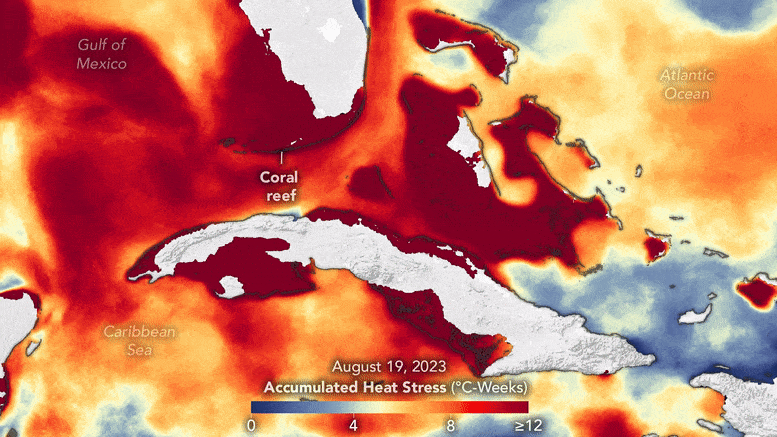
In 2023, rising sea temperatures, amplified by human activities and El Niño, threatened coral reefs, especially around Florida, Cuba, and the Bahamas. Satellite data indicated high risks of coral bleaching and mortality in these regions by mid-October.
The seas around Florida, Cuba, and the Bahamas saw large accumulations of heat stress beginning in summer 2023, with implications for the health of coral reefs.
For several months in 2023, global sea surface temperatures reached record-high levels. This surge was fueled by decades of human-caused climate warming and a recent boost from the natural climate phenomenon El Niño. Some areas—including the seas around Florida, Cuba, and the Bahamas—saw particularly high temperatures, with implications for the health of coral reefs.
The Impact on Coral Reefs
Corals flourish within a small temperature range and become stressed when water is too hot or cold. Bleaching occurs when stressed corals expel the algae that live inside them, stripping corals of their color. Extreme bleaching can leave a reef susceptible to starvation, disease, and even death. Observations made by divers in the Florida Keys found that the marine heatwave in the summer of 2023 caused widespread bleaching.
This animation shows the evolution of accumulated heat stress from July through September 2023.
Using Satellite Data to Monitor Corals
Satellite data offers insights into the stress levels of corals. The animation above shows the evolution of accumulated heat stress from July through September 2023. The colors depict “degree heating weeks” (°C-weeks)—a measure that provides an estimate of the severity and duration of thermal stress. Data for the product are compiled by NOAA’s Coral Reef Watch, which blends observations from polar orbiting satellites such as the NASA-NOAA Suomi NPP, and from geostationary satellites such as GOES, with computer models.
Observations have shown that when the accumulated heat stress reaches a value of 4, significant coral bleaching can result. At values of 8, coral bleaching and widespread mortality are likely. By midway through this animation, in August, heat stress across much of the region already soared well above both of those thresholds. According to NOAA, cumulative heat stress by late September 2023 hit 22°C-weeks (40°F-weeks), nearly triple the previous record for the region.
Early Signs and Effects of Bleaching
Bleaching was already observed in some areas as early as July. Notice that areas of coral reef (gray) near the Florida Keys, Cuba, and the Bahamas, are among the first areas to show high cumulative heat stress. Hurricane Idalia in late August helped cool surface waters somewhat, but only temporarily.
Nearing mid-October, waters around the Florida Keys were under a bleaching watch. Further south, waters around parts of Cuba and the Bahamas remained at bleaching alert level 2, the highest level of the scale, signifying that severe bleaching and mortality are likely.
NASA Earth Observatory animation by Wanmei Liang, using Daily 5km Degree Heating Weeks data from Coral Reef Watch. Coral reef data from UNEP-WCMC, WorldFish Centre, WRI, TNC.









“…, nearly triple the previous record for the region.”
And, the antarctic ‘Ozone Hole” had an anomalously early start this year, with the extent and depth of the hole also being unusual as well. Are these the result of the Hunga Tonga volcano explosion last year, or is it a coincidence? That is, is this a weather event, or is it symptomatic of anthropogenic global warming?
“Satellite data indicated high risks of coral bleaching and mortality in these regions by mid-October.”
It is past mid-October. What is happening now?